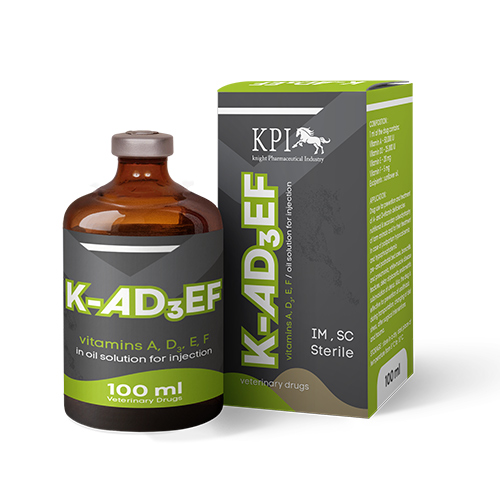
(solution of vitamins A, D3, E, F in oil for injection)
DESCRIPTION:
Transparent oily liquid from light yellow to light brown color odorless.
COMPOSITION:
1 ml of the drug contains:
Vitamin A – 50,000 IU; Vitamin D3 – 25,000 IU; Vitamin E – 20 mg; Vitamin F – 5 mg; Excipients: sunflower oil.
PHARMACOLOGICAL CHARACTERISTICS: Vitamin A belongs to the fat-soluble vitamins participates in redox processes in carbohydrate and fat metabolism, affects on mineral and hormonal exchanges.
The mechanism of action of vitamin A provides regulation of oxygen uptake in biochemical processes; inhibition of insulin activity and strengthening of conversion of carbohydrates to proteins in the liver; activation of the metabolism of calcium and magnesium providing formation of skeleton; slowing of formation of keratohyalin granules in the lipid layer of cell membranes and maintaining of elasticity of cell membranes; ensuring of normal function of organs of vision, skin, respiratory tract, alimentary canal, reproductive system.
Vitamin A plays an important role in interaction of proteins with lipids in cell membranes, providing their
functioning and regulates the permeability. Most sensitive to vitamin A deficiency are lysosomal membranes, in case of its lack is increased elimination their enzymes. Structural violations of mitochondria membranes in hepatocytes leads to disorders of breathing and phosphorylation process. Lack of vitamin A in
animal organism increases free radical oxidation; in animal tissues is disturbed biosynthesis of proteins, changing their electrophoretic properties. Also, vitamin A provides the normal functioning of
the reproductive functions of animals: spermio- and oogenesis, development and growth of embryos, the early onset of puberty, the synthesis of sex hormones.
Vitamin D3 belongs to a group of fat-soluble vitamins, affects on the metabolism of calcium and phosphorus,begining from its absorption in the gut and ending with removal from the body.
Promotes the formation of bone tissues during growth period, in case of treatment of rickets, osteomalacia, bone fractures. Regulates calcium and phosphorus content in the blood and bone tissue, provides a physiological ratio of them in the body.
Vitamin E belongs to a group of fat-soluble vitamins and plays an important role as a regulator of lipid biosynthesis of protein; increases levels of myosin and actomyosin; provides ATP metabolism; prevents oxidation of fats, fatty acids and sterols, delaying oxidation of fats; prevents the formation of toxic metabolites; slows the metabolism of carbohydrates, proteins, nucleic acids and steroids, and provides resistance of
erythrocytes to hemolysis and oxidation.
Vitamin E provides a structure of cell membranes and intracellular inclusions, which provides lysosomal stability and delays exiting from them lysosomal hydrolytic enzymes and prevents their participation in the development of dystrophy in case of white-muscle disease.
Effect of vitamin E on the membrane structures positively effects on stability and functional activity of the surface epithelium of the mucous membranes of the digestive canal, uterus, conjunctiva.Vitamin E ensures
the normal functioning of the digestive and reproductive apparatus. Helps males to regulate spermatogenesis and reduces the number of pathologically changed spermatozoa and prevents degeneration of
the epithelium of seminiferous tubules. Vitamin helpsfemales to contribute the attachment of the embryo to the uterus and fetal development.
Vitamin F lowers the content of cholesterol in blood, helps to normalize blood coagulation processes, participates in lipid metabolism, increases the level of albumin. In case of lack of vitamin F in animal organism is observed increase of cholesterol and beta-globulins in blood, reduction of the level of albumin and in
chronic cases animals have dermatitis
APPLICATION:
Drug use for prevention and treatment of A- and D-vitamin deficiencies, nutritional
and secondary osteodystrophy of farm animals and for their treatment in case of postpartum hypocalcemia and hypophosphatemia, pre- and postnatal bed sores, bronchitis and pneumonia, white-muscle disease, fractures, delay of placenta, endometritis, subinvolution of uterus. Also, the drug is effective for prevention of urolithiasis, during transporta- tion, changing
of diet, stress, after surgical interventions and trauma.
DOSAGE:
The drug with a preventive purpose is administered intramuscularly or subcutaneously once every 7-10 days for therapeuticpurposes – intramuscularly once every 5 days up to recovery (5-8 injections) in the future (if necessary) drug is injected
at prophylactic doses. Inside drug use every day at specified prophylactic doses. Doses of the drug are calculated by vitamin A.
| TYPE OF ANIMAL | DOSE PARENTERALLY ML | THE DOSE INSIDE ML / DAY | |
| PREVENTIVE | THERAPEUTIC | ||
| Nonmilking cows | 10 | 10 | 1.5 |
| Milch cows | 12-10 | 12-10 | 2.5 |
| Young cattle kg of body weight) | 2,5-3,0 | 2,5-3,0 | 0,5-0,4 |
| Sows (second half of gestation) | 3,0 | 3,0 | 0,4 |
| Lactating sows | 4.0 | 5.0 | 0.6 |
| Piglets (30-20 kg) | 1.0 | 1,0-1,5 | 0,1-0,12 |
| Mares in foal | 7.0 | 10,0 | 0,6-0,7 |
| Lactating mares | 8.0 | 12.0 | 0,7-0,8 |
| Foals aged 12-6 months. | 2.0 | 3.0 | 0.3 |
CONTRAINDICATIONS: Not established.
PRECAUTIONS: In case of application of the drug it is necessary to balance the diet of animals by protein, calcium, phosphorus, magnesium and trace elements..
HOW SUPPLIED : 100 ml bottles made of dark glass, closed with rubber plugs and aluminum caps.
STORAGE: Dry, dark place at temperature from 5°C to 15°C.
